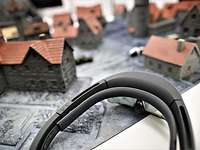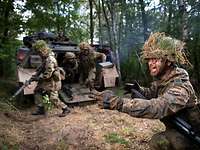
Army capabilities
The particular capabilities of Army soldiers are available in all branches of the Army and should therefore not be considered inherent to any one specific branch. They serve the purposes of national and collective defence operations and are requested on a sound legal basis in certain situations and for operations at home and abroad.
Defending Europe
The mission of the armed forces of the Bundeswehr is to defend the Federal Republic of Germany against potential adversaries and to protect its citizens. At the time of the Cold War, the armed forces directly faced the troops of the Warsaw Pact at the border. The borders at which the Bundeswehr performs its main defence tasks today have shifted eastwards. Together with their partners and allies in NATONorth Atlantic Treaty Organization and the European Union, the German armed forces deter potential adversaries at the external borders of the EUEuropean Union. National defence means protecting the Alliance. The Army plays a prominent role in this respect.
Collective defence requires particular capabilities in terms of command and control, joint intelligence, surveillance and reconnaissance, support, and in combat activities conducted by individual army units. These result, for instance, from conditions such as climate and terrain characteristics or the size of the area to be defended.
Disaster relief
Every serviceman and woman learns how to act in case of a CBRNchemical, biological, radiological, nuclear alert. Protection against the effects of chemical, biological, radiological and nuclear agents is a CBRNchemical, biological, radiological, nuclear defence capability that also plays a central role in any operation. In addition, the Bundeswehr uses its capabilities to provide support in the event of disasters such as major fires, floods or snow disasters if requested in the framework of administrative assistance. Another life-saving capability of the Bundeswehr is the search and rescue (SARSearch and Rescue) service. Drawing on its helicopters, the Army is responsible for search and rescue service over land.
Army Reconnaissance
Efficient and effective collection of information is an essential element of military intelligence. The ISRIntelligence, Surveillance and Reconnaissance corps combines those Army forces that gather all the information needed by the force commanders so that they can make a decision based on a rationale and plan and conduct their operations accordingly, thus winning the battle. This may include information about the enemy, but also information about any other forces in the area as well as about the terrain. State-of-the-art analytical and data processing methods as well as special operations forces such as long-range reconnaissance forces are used for joint intelligence, surveillance and reconnaissance purposes. These specialised forces are able to operate behind enemy lines to conduct combat reconnaissance.
Combat in rough terrain
Army servicemen and women must be prepared for national and collective defence. As the territory of the Alliance also includes rough terrain along with regions that experience long winters, mountain infantry and special operations forces train for winter warfare and combat in difficult terrain. The Army’s branches additionally practice fighting in built-up areas. This also involves the employment of infantry in interaction with armour elements. Joint fire support is another Army capability. In this regard, Army personnel assist in battlefield surveillance, target acquisition and target development, among other things.



